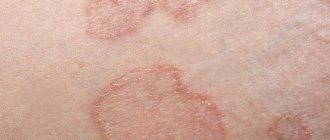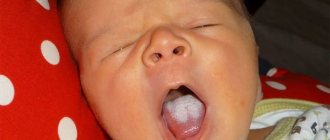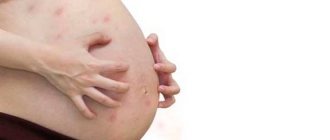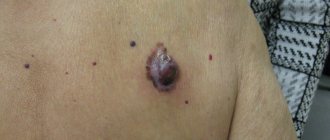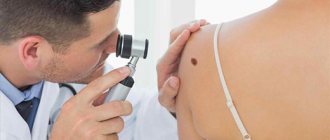What is this phenomenon in pregnant women?
Dermatosis is a consequence of severe hormonal imbalance. Experts compare this phenomenon with the consequences of adolescence. This disease is expressed in various skin lesions, which are observed only during pregnancy and then disappear almost without a trace.
Dermatosis requires monitoring by specialized doctors, and in severe forms, treatment. In some cases, the disease can lead to death of the intrauterine fetus.
A pregnant woman's skin can behave in any way. It may become dry, or, conversely, very wet, that is, severe sweating will appear.
In the following photographs you can see examples of what dermatosis looks like during pregnancy in women:
Specialist help
But it is advisable, of course, to consult a doctor who will select adequate therapy. Treatment will include taking child-safe anti-inflammatory drugs and antihistamines. In this case, the course must be carried out under the close attention of a specialist.
Safe antiseptic and antifungal agents include those that contain the following active ingredients:
- metronidazole;
- azelaic acid;
- clindamycin;
- nystatin;
- erythromycin;
- terbinafine;
- mupirocin.
The choice of treatment depends on the severity of the manifestation and the general condition of the pregnant woman. In some cases, the doctor, after examining the patient, may prescribe chlorpyramidine or suprastin.
Causes of the disease
One of the main reasons for the manifestation of dermatosis during pregnancy is hormonal fluctuations. A large amount of harmful substances also increases the chances of this disease manifesting itself. Experts also include disruption of the thyroid gland and the body’s immune system as a whole as causes.
Dermatosis may worsen if a pregnant woman has:
- overweight;
- diabetes;
- strong emotional stress;
- prolonged toxicosis in the first months of pregnancy;
- consumption of allergens.
The cause of manifestations of dermatosis can be identified by scraping the affected areas of the skin in the laboratory.
Most often, dermatosis occurs in women who are carrying their first child.
Why does the disease appear?
The pathology is hereditary. It will manifest itself with a probability of up to 80% if both parents are atopic, and with a probability of 30-50% if one of them suffers from the pathology. The disease, although with a lower probability (up to 20%), can be detected if one of the more distant relatives has allergic rhinitis, asthma, or eczema.
The immune system of atopic people is overactive and prone to inflammation. The protective barrier is weakened, and the skin dries out and is more susceptible to infections. In response to the penetration of allergenic substances, the body begins to increase the production of immunoglobulin E and histamine. The permeability of capillaries increases, and as a result, allergic symptoms appear - itching, redness, rash, etc. Genetic predisposition does not mean that a person will certainly develop a pathology. After all, it is not dermatitis itself that will be inherited, but only the tendency to it.
The following factors (triggers) can provoke a pathological process:
- life in a metropolis with developed industry and unfavorable ecology;
- frequent inclusion in the menu of products with a high allergy index;
- smoking (passive smokers are also at risk), alcohol;
- uncontrolled use of medications;
- bacterial, fungal and viral infections;
- excessive psycho-emotional stress.
Catalysts of pathology can also be flowering plants, household chemicals, clothing made of synthetic fabrics, cosmetics, saliva and hair of pets, etc. Sudden changes in humidity and temperature, and lack of sun can affect this. Atopy worsens in winter due to excessive dry air from working radiators. Sun and high humidity lead to remission and relief of the condition.
When a woman is pregnant, in addition to the above, her hormonal levels change significantly. Among pregnant women suffering from atopic dermatitis, 20% of women experience an exacerbation of the disease, and in the remaining 80% of patients, atopy appears for the first time. Typically, these 80% have naturally dry, easily irritated skin (so-called atopic diathesis), and/or have relatives who suffer from allergies.
External description of dermatosis
One of the common signs of dermatosis is the appearance of dark pigment spots on the skin, which can be found in almost every pregnant woman. They can appear on any part of the body. Usually, the longer the period, the more visible these spots become. This manifestation is considered a normal condition of the body that is not subject to treatment.
Manifestations of dermatosis can be in the form of:
- bubbles;
- ulcers;
- rash;
- crusts;
- warts;
- acne;
- eczema;
- itching.
Diet
As already mentioned, allergens that provoke an exacerbation can also come from food and, therefore, one of the mandatory points of treatment is nutrition in accordance with a hypoallergenic diet. Its essence is to exclude products that can act as potential allergens.
In the first place it is worth putting seafood, food containing various spices and seasonings, as well as coffee, chocolate, honey and smoked foods, nuts and citrus fruits. You may know a specific product that can cause signs of an allergy in you; it should be completely excluded throughout pregnancy. The diet must be followed throughout the entire period of exacerbation, and after the danger has passed, foods must be introduced gradually, no more than once every two to three days.
Symptoms
Symptoms most often depend on the type of dermatosis. Diseases that occur during pregnancy can be divided into:
- atopic dermatosis;
- pemphigoid;
- cholestasis;
- polymorphic dermatosis.
Atopic dermatosis can manifest as eczema. This condition is characterized by itchy spots on the bends of the joints. This group also includes prurigo and pruritic folliculitis. Atopic dermatitis in pregnant women can only be distinguished by a specialized doctor. This species is not dangerous either for the expectant mother or the fetus.
Prurigo
Prurigo in pregnant women does not occur as often as eczema, but in any trimester. Pruritic folliculitis is very rare, but is accompanied by severe itching, as well as a large number of pimples and nodules that can be seen on the back, chest, and least of all on the stomach. This group resolves on its own without the use of special treatment.
Pemphigoid is very rarely observed in pregnant women. It appears in the form of plaques, which then become blisters. This species can affect the mucous membranes of the body of the expectant mother. Most often, symptoms disappear towards the end of pregnancy, but they can also worsen during childbirth, when the body is under severe stress. They disappear immediately after childbirth without the use of treatment.
Cholistasis is body itching during pregnancy, which most often manifests itself in the abdominal area. With this type there are absolutely no stains or rashes. Itching may also appear on the palms of the hands as well as the soles of the feet. This type of dermatosis can sometimes lead to early labor or fetal death.
Polymorphic dermatosis is accompanied by rashes in the form of plaques and blisters. It is most often observed in pregnant women with very dry skin and rapid weight gain in the last trimester. Lesions can be observed in the abdomen, chest, and thighs of women. The face and mucous surfaces of the body are almost always clean. This type of dermatosis is not dangerous for both the expectant mother and the fetus.
In later stages, atrophic stripes, called stretch marks, may appear. They appear in many pregnant women. To prevent this condition, you must use a moisturizer daily.
Kinds
For reasons that cause pathological processes, several types of dermatitis are distinguished.
Atopic
Atopic dermatitis always occurs in a chronic form, it is first diagnosed in childhood, and recurs in adults. Exacerbation of dermatitis during pregnancy can be caused by taking medications, eating allergenic foods, or inhaling vapors of various chemicals.
Atopic dermatitis during pregnancy is caused by a woman’s complicated allergic history (hay fever, bronchial asthma in close relatives), and factors contributing to the onset of relapse are changes in hormonal levels and weakened immunity.
Allergic contact
Allergic dermatitis during pregnancy develops as a response to skin contact with an irritating substance, occurring immediately after exposure or after a short period of time (usually 5-7 days). The severity of symptoms is determined by the concentration and time of exposure to the allergen, and skin sensitivity.
Allergic inflammation, in turn, happens:
- irritable – caused by exposure to physical (high temperature, frost) or chemical (cleaning products, cosmetics, perfumes, external pharmacological preparations, etc.) factors;
- photocontact - occurs when exposed to ultraviolet radiation.
According to statistics, allergic skin lesions in women during pregnancy are most often caused by synthetic fabrics, cosmetics, household chemicals, jewelry, varnishes, and paints.
If allergic dermatitis during pregnancy is manifested by inflammation of the skin in areas directly in contact with the irritating agent, then in the atopic form, any areas of the skin can be involved in inflammatory processes, but most often the face, elbow and knee bends, and buttocks are affected.
Seborrheic
Seborrheic dermatitis is characterized by inflammation of areas of the skin where many sebaceous glands are localized: on the scalp, behind the ears, on the face along the hairline, as well as on the neck and back.
Inflammatory processes in seborrheic dermatitis are associated with increased production and changes in the composition of sebum, and disruption of the sebaceous glands in pregnant women occurs due to changes in hormonal levels.
Doctors distinguish two types of seborrheic dermatitis:
- dry - accompanied by severe dryness and flaking of the skin, whitish dry scales appear on the affected areas, which conventional cosmetics do not help get rid of;
- oily – the skin becomes covered with massive pustular rashes, the face becomes shiny from excess sebum production.
Perioral and periorbital
Perioral dermatitis is characterized by the appearance of a rash in the form of pimples, red spots, and blisters in the mouth area. As inflammation worsens, the rash spreads to the cheekbones and area around the eyes, and periorbital dermatitis develops.
The inflamed elements can be single or merge with each other, forming extensive foci. The appearance of the rash is accompanied by a burning sensation and itching. When scratching, persistent pigmentation remains at the site of the inflamed elements.
The development of perioral and periorbital dermatitis can be caused by:
- cosmetics;
- toothpastes containing fluoride;
- irrational long-term use of corticosteroid ointments (for example, in the treatment of acne vulgaris and rosacea).
Treatment plan from doctors
Specialized doctors emphasize that the manifestation of any types of dermatosis does not affect the development of the intrauterine fetus. But severe itching can harm a woman’s psychological and emotional state, disrupting her sleep. The consequences of itching can be scratches that can become infected.
When the rash covers a large area of skin, doctors recommend using antihistamines in tablet form, such as Zyrtec or Claritin. Other antihistamines should not be used during pregnancy. Experts almost always prescribe a dosage of one tablet per day. The consequences include sedation.
Antihistamines should be taken in the evening and driving should be limited.
The psychological state of the expectant mother can have a detrimental effect on the nervous system of the intrauterine fetus, therefore, in some cases, doctors may prescribe herbal sedatives.
Among creams, emollients based on chamomile extract have a good effect on the skin.
Doctors prescribe the dosage of any drug taken during pregnancy individually for each woman and calculate it based on weight, age, and general health. For minor skin rashes, it is recommended to limit yourself to ointments and creams only.
Any rashes must be checked at the beginning, before using various drugs, for danger in relation to the health of the expectant mother and the course of pregnancy.
For any type of dermatosis, it is necessary to consult not only a gynecologist, but also a dermatologist.
Does the pathology affect the course of pregnancy and the fetus?
Atopy is not an obstacle to conceiving a baby, does not affect pregnancy, does not harm the child and will not affect childbirth. Due to incessant itching and insomnia, the expectant mother usually becomes nervous, tearful, and feels chronic fatigue. To a certain extent, her psycho-emotional state is transmitted to the baby, but not enough, of course, to talk about a significant impact on the fetus.
However, the expectant mother needs to know that against the background of atopic dermatitis, a genetic predisposition to atopic diseases (hay fever, asthma, eczema) in the child cannot be ruled out. It doesn’t necessarily turn into a disease, but there is a risk.
Additional treatments
The main rules are high-quality body care and hygiene using moisturizing creams.
To reduce itching, avoiding spicy foods and smoked foods, spices, as well as citrus fruits and chocolate can help.
Additional medications may be required to remove harmful substances and generally cleanse the body. One drug that is safe for the health and development of the fetus is Polysorb, which consists of silicon. It removes harmful substances naturally. It cannot be taken constantly, as it removes useful substances and vitamins from the body of a pregnant woman.
A decoction of chamomile and oak bark will help relieve itching. You should wipe the affected areas of the skin several times a day.
You should also avoid using cosmetics and deodorants. You can only use baby creams, moisturizers, or special ointments for pregnant women.
Adviсe
You can alleviate the condition of dermatitis and speed up the treatment process by carrying out regular wet cleaning and airing the room. It is necessary to remove from the apartment all objects in which dust can accumulate, and choose clothes only from natural fabrics. It is important to exclude the use of any perfumes and cosmetics and give up bad habits.
In addition, if you have dermatitis, you must follow a strict diet and remove allergenic foods from your diet:
- honey;
- nuts;
- chocolate;
- citrus;
- tomatoes;
- fat meat;
- any pastries and baked goods;
- smoked meats and marinades;
- eggs.
It is necessary to consume more fermented milk products and permitted vegetables and fruits.



